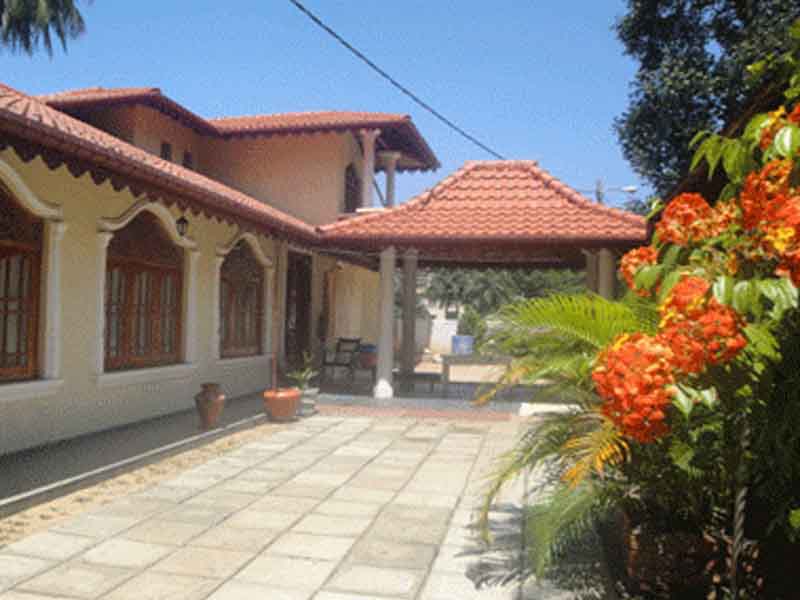Asgiri Gedige Raja Maha Viharaya

North from the lake is situated the Asgiri Maha Viharaya, the other monastic centre of the Siyam Nikaya. This temple is believed to be considerably older 'than the Malwatu Viharaya and the "Asgiriya Talpata" voices this claim.
Asgiri Maha Viharaya was founded by Commander Siriwardhana at the inquest of Parakramabahu IV of Kurunegala (1305-1335 A.D.). The original buildings were set up in the Trinity College premises. The bhikkhus to take up residence here was sent from Valasgala hermitage in Yapahuva. The name Valasgala is translated into Pali as "Acchagiri" and the present Sinhalese name Asgiri is derived from it. According to another legend Asgiri was named after the mother queen of Vikramabahu who was cremated in the present cremation ground or Adahana Maluva at Asgiriya.
It is said that she built a temple called "Talagahamulla Viharaya" which later became the "Asgiri Viharaya". At present the Asgiri Temple Complex is called "Heyagiri Wijesundararama". Heyagiri is a erroneously translation in to Sinhalese the pali word Acchagiri. During the last king of Kandy, His Commander-in-Chief Urulewatte Wijesundara Rajakaruna Seneviratne built a new temple near the old one and the whole temple complex became to known as "Heyagiri Wijesundararama".
The King also made land grants to the temple and an inscription by him to this effect is still seen nearby. But the popular name Asgiriya continued to be used. During the reign of Rajadhi Rajasinha (1779-1797 A.D.) the streets of Kandy were straightened and as a result the old buildings of the Viharaya had to be demolished and a new temple was built at "Udamadapota". This is now known as" Pahala Pansala "or lower temple. The demolition for the second time took place during the reign of Vimaladharmasuriya II (1687 - 1707) when he was building a wall round the city.
It is seen from the history of the Asgiri Viharaya that almost all the rulers of the Kandyan Kingdom have contributed much towards its development. On the other hand, it was mainly the monks of this Chapter who have safeguarded the Tooth Relic on behalf of the ruling monarch during troublesome times.
Again, it was Wariyapola Sumangala Anunayake Thero of the Vihara who re-hoisted the Sinhalese flag in protest when the British hoisted their flag at the time of the signing of the Kandyan Convention in 1815.
Among the historical monuments belonging to the Asgiriya Vihare are the "Purana Viharaya" or the Old Temple and the "Aluth Viharaya" or the New Temple which was built by Pilimathalawe Dissawe in 1768. The temple known today as "Meda Pansala" was built by Meegastanne Dissawe in Dumbara in 1767.
Parana Viharaya contains a sedate figure if Buddha under a Makara Thorana Arch, and the interior is very similar to that of Gedige Viharaya. The figures on each side of Buddha are the deity Natha on his right and deity Saman on his left. A new "Aluth Vihare" was built by the Pilimathalawe Adhikaram, a son of the Pilimathalawe Dissawe in 1801. This viharaya has a recumbent figure of Buddha hewn out of Rock thirty six feet long. Asgiriya also has two poya-ges.
One of the most important monuments standing in the Maha Vihara Grounds is the "Gedige Viharaya" in the "Adahana Maluwa" or the Royal Cremation Ground. According to the legend this viharaya was found by Vickramabahu (Senasammatha?) in memory of queen Chandrawathie who was cremated here. A beautifulgedige style image shrine and a monastery constituted this viharaya and was known as "Rathnabanu". The viharaya had three maluwas or terraces, Uda (upper) maluwa, Meda (centre) Maluwa, Palle (lower) Maluwa. The cremation of the Royal family members was at the Meda Maluwa, therefore the temple in the premises was known as the "Adahana Maluwa Gedige Viharaya".
Historically, Adahana Maluva Gedige is the second oldest monument in the city and architecturally it belongs to the same school that influenced the monuments at Natha Devale and Gadaladeniya Vihara in Uda Nuwara. It is believed that the plan of the Natha Devala Gedige has been made use of here. Adahanamaluve Gedige Viharaya plays a significant role in the Kandy Esala Perahara in that in final night the Relic Casket of the Dalada Maligava is deposited there until the commencement of the last day Perahara which begins from this site. This is done in order to fulfil a wish of King Kirti Sri Rajasinhe (1747 - 1781), who, having re-started the Dalada Perahara, ordered that the Casket be deposited at Adahana Maluva as a mark of respect to his queen mother cremated there.
Adahanamaluwa Gedige Asgiriya
Adahana Maluva was the place where the dead bodies of the kings of Kandy were burned and their remains were buried. Valentyn says that the body of Vimaladharmasuriya I (1592 - 1604), who died in 1604 was "cremated according to the custom of his country in a princely arbour". Maha Astana, the son of Vimaladharmasuriya I, and Dona Catherina who died in 1612 was also cremated there with "very great state and royalty, while great mourning lamentation were taking place at the sepulcher". He also speaks of Dona Catherina who died in July 20, 1613. "She was cremated on the 21st with great splendour on the same spot where the funeral of her son had been celebrated".In 1878-80 the railway line to Matale was constructed under the Adahana Maluva in a tunnel and the last of the tombs which was almost the only remains of the Royal burial ground was destroyed.
Among the historical monuments in the city of Kandy are three other important temples belonging to the late Kandyan period. They are Gangaramaya, Huduhumpola and Nittawela. These stood outside the boundaries of the old city but today they are within the municipal limits because of their close proximity to the ancient city.
